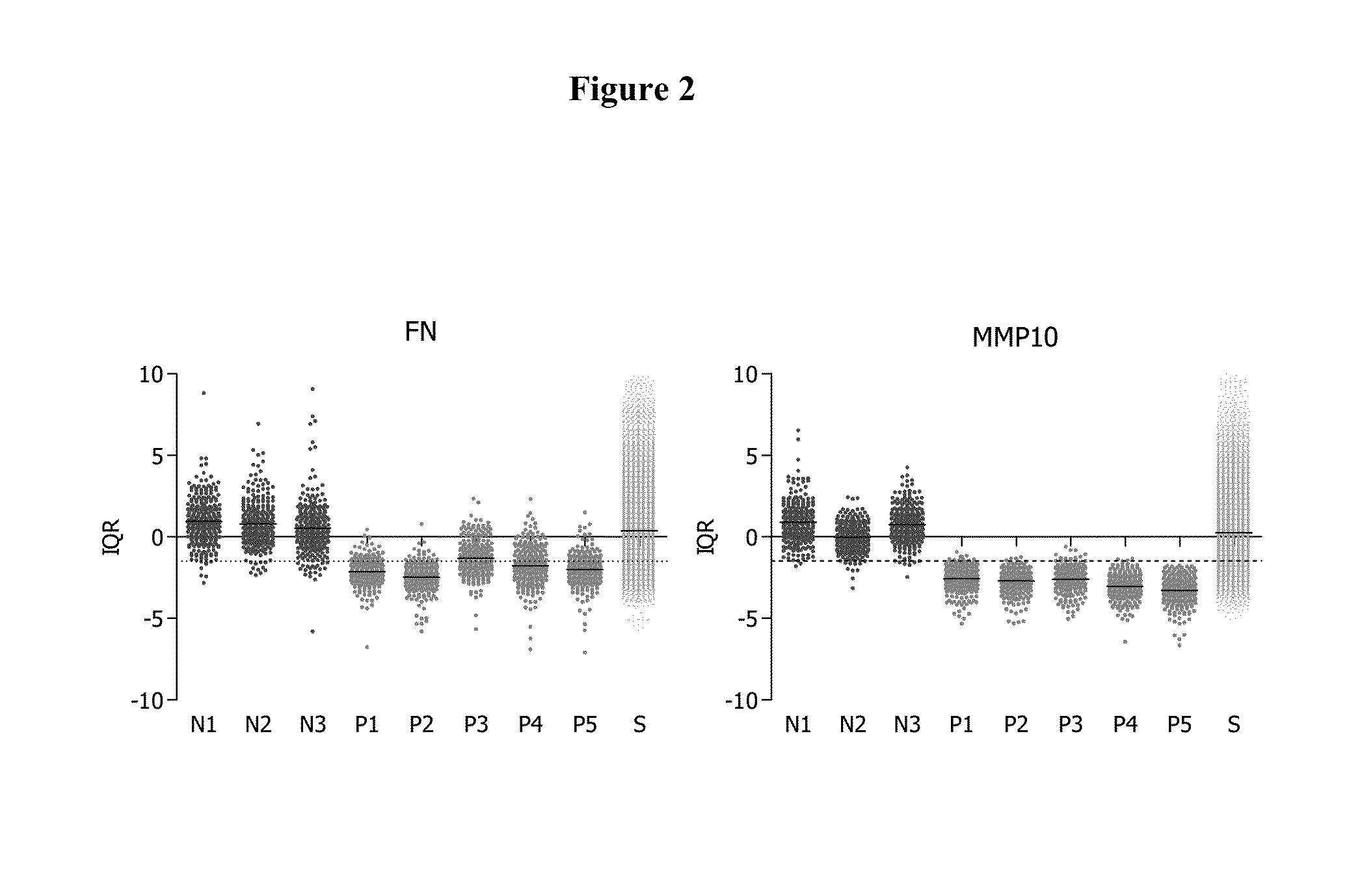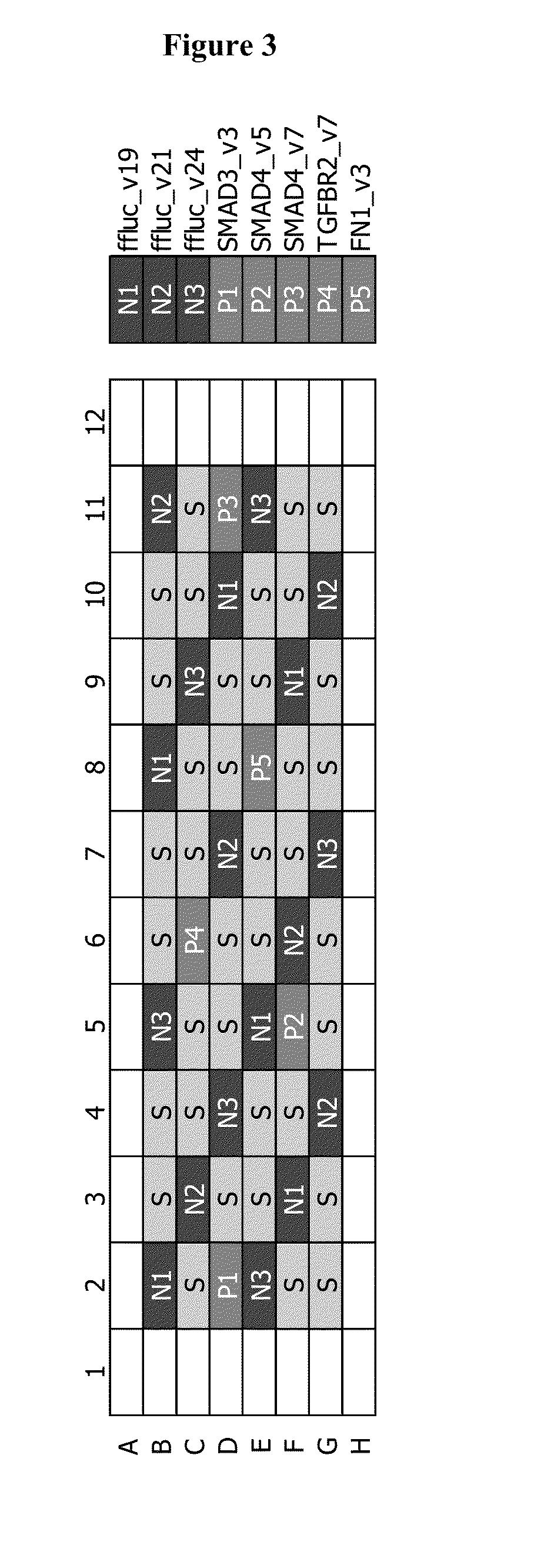Molecular targets and compounds, and methods to identify the same, useful in the treatment of diseases associated with epithelial mesenchymal transition
a mesenchymal transition and molecular target technology, applied in the field of molecular biology and biochemistry, can solve the problems of promoting carcinoma progression, adversely affecting organ fibrosis, and difficult to identify the inhibitors of those targets, and achieve suppression of release or expression, and inhibit epithelial mesenchymal transition.
- Summary
- Abstract
- Description
- Claims
- Application Information
AI Technical Summary
Benefits of technology
Problems solved by technology
Method used
Image
Examples
example 1
EMT Assay Primary Screen
1.1 Background
[0233]Airway remodeling and fibrosis are important features in the pathogenesis of fibrosis. Epithelial mesenchymal transition (EMT) has been proposed as a mechanism for an increase in number of fibroblast-like cells and collagen overproduction leading to fibrosis. Several studies have demonstrated that EMT may occur in human lung epithelial cell lines and primary bronchial epithelial cells upon exposure to TGF13. A special TGFβ-induced EMT assay was developed in primary Human Bronchial Epithelial Cells (HBEC) using several common markers of EMT.
1.2 Cell cultures and donors
[0234]HBEC were obtained from the Dept of Pulmonology (LUMC, Leiden, The Netherlands). HBEC were derived from lung resection tissue of patients undergoing surgery for lung tumors. Bronchial epithelial cells were isolated by protease digestion and cultured as previously described (van Wetering, 2000). Three donors were used throughout all experiments. For primary screen and on-...
example 2
Re-Screen Using EMT Assay
2.1 Background
[0251]In the re-screen the hits from the primary screen were screened again using newly repropagated viruses on a different COPD HBEC donor, Br291.
2.2 Positive and Negative Controls and Plate Layout
[0252]The assay setup was kept similar to the primary screen, but with a different plate layout. To enable hit calling based on the distribution of the negative controls, the plate layout included at least 30% negative controls. Five positive controls were taken along for re-screen (see Table 6). The plate layout used in re-screen is presented on FIG. 3. Positive control TGFβR1_v1 was replaced with FN1_v3. This shRNA control was used as a positive control in the FN read-out, but not for the MMP10 read-out.
TABLE 6an overview of controls used in EMT re-screenControl shRNASequenceSEQ ID NO:Ffluc_v19GAATCGATATTGTTACAAC35Ffluc_v21ATATCGAGGTGAACATCAC36Ffluc_v24GCAGTCAAGTTTCCACAAC37SMAD3_v3GCTCCATCTCCTACTACGA38SMAD4_v5GTGTTCCATTGCTTACTTT39SMAD4_v7GCAGAGTAAT...
example 3
EMT2 Validation Assay
3.1 Background
[0257]The EMT assay with cellular markers as read-out (designated EMT2) was employed as a secondary assay to validate the 438 confirmed candidate Targets of the re-screen. The purpose of the secondary assay was to validate targets identified in the re-screen in an EMT assay using a different read-out, the ratio of cellular expression of E-cadherin and fibronectin, measured by high content imaging on an InCell 2000 instrument (GE Healthcare) following immune staining with anti-FN and anti-E-cadherin antibodies.
3.2 Cells and Donors
[0258]Donor Br282 was used for the validation screen. Cells were obtained according to the protocol described in Example 1.
3.3 Controls and Plate Layout
[0259]The lay-out, based on the rescreen plate lay-out, uses the 60 inner wells of a 96-well plate to reduce the plate or edge effect (FIG. 5). Furthermore, 30% of the plate was used for negative controls to facilitate hit calling. The improved distribution of the controls a...
PUM
| Property | Measurement | Unit |
|---|---|---|
| temperature | aaaaa | aaaaa |
| molecular weight | aaaaa | aaaaa |
| time | aaaaa | aaaaa |
Abstract
Description
Claims
Application Information
 Login to View More
Login to View More - R&D
- Intellectual Property
- Life Sciences
- Materials
- Tech Scout
- Unparalleled Data Quality
- Higher Quality Content
- 60% Fewer Hallucinations
Browse by: Latest US Patents, China's latest patents, Technical Efficacy Thesaurus, Application Domain, Technology Topic, Popular Technical Reports.
© 2025 PatSnap. All rights reserved.Legal|Privacy policy|Modern Slavery Act Transparency Statement|Sitemap|About US| Contact US: help@patsnap.com



